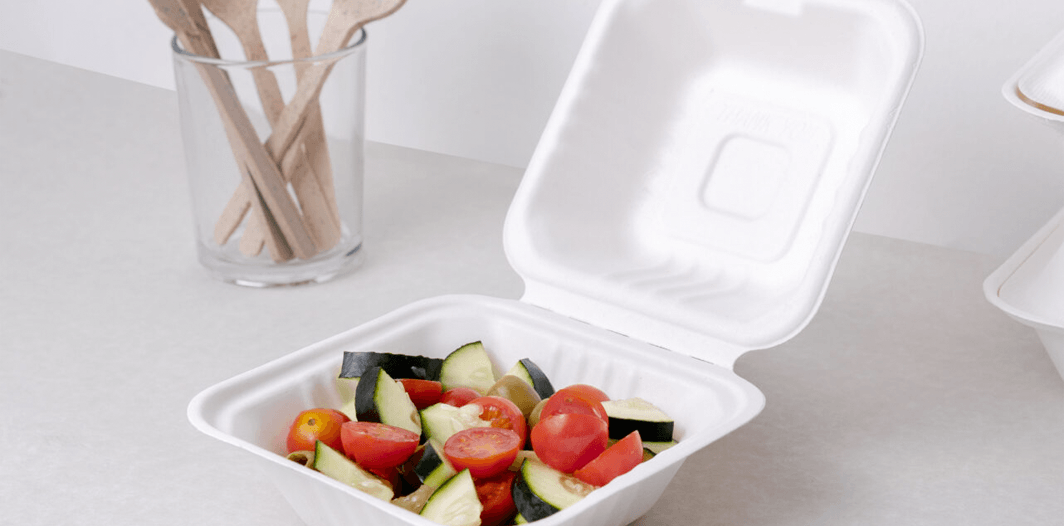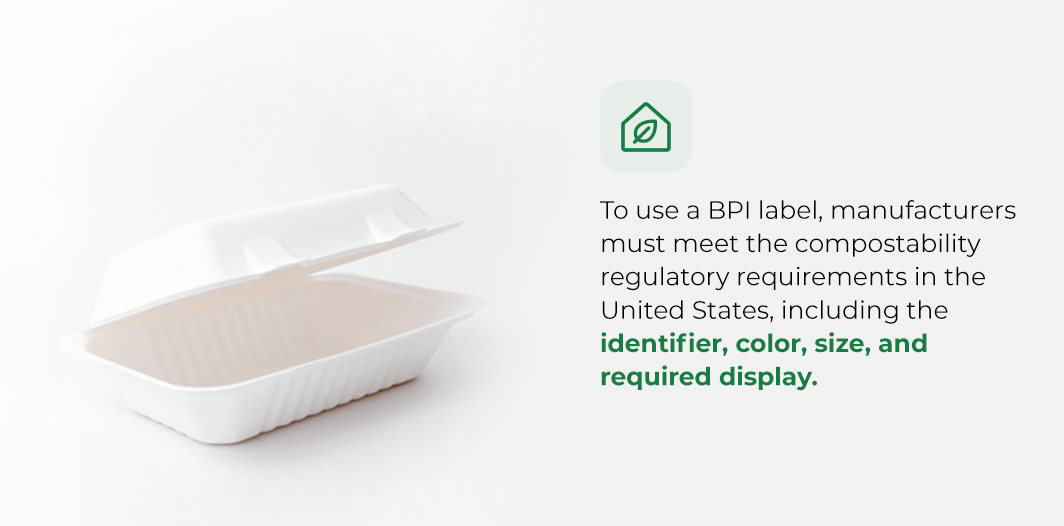Understanding Compostable Certification

Content
- Defining Certified Compostable Products
- What Does BPI Compostable Mean?
- Compostable Certification Standards and Regulatory Compliance
- What Is the ASTM D6400 Standard?
- Examples of Compostable Products and Bioplastics
- Home Compostable vs. Industrial Compostable: Key Differences
- Defining Marine and Landfill Degradation
- How to Identify BPI-Certified Compostable Products
- Regulatory Compliance and Avoiding Greenwashing Risks
- Material Options and Industry Adoption
- Cost Considerations and Business Impact
- Partner With Greenprint for Certified Compostable Solutions
The world is facing a plastic pollution crisis. Plastic is destructive and dangerous, polluting our oceans, waterways, and land, poisoning animals, and even finding its way into human blood where it may lodge in organs, damage cells, and lead to chronic illness or premature death. While recycling is an option for some materials, 85% of recyclable plastics still end up in landfills.
Compostable bioplastics have been introduced as an alternative to traditional plastics. These products are made from plant fiber such as sugar cane, agave, and cornstarch. Transitioning to bioplastics as a sustainable packaging solution significantly benefits organizations looking to meet sustainability goals.
Defining Certified Compostable Products
A compostable product is made from materials only capable of being processed by compositing, anaerobic digestion and other processes that result in decomposition by bacteria of other living organisms. While recycling plastics is one method of reducing plastic waste, compostable solutions provide consumers with an ethical alternative that eliminates the use of plastic products.
What Does BPI Compostable Mean?
The Biodegradable Products Institute (BPI) has developed a certification that supports manufacturers in differentiating their compostable products and helps consumers choose them wherever possible. A BPI-certified product indicates users can cycle the item back into the soil safely at any commercial composting facility.
BPI plastic certification is a rigorous and detailed process. Materials must satisfy several stringent requirements to be defined as compostable, including:
- The product cannot be a redesign of a product better suited to recycling.
- The product should not have to be disassembled to be composted.
- The product must be compatible with organic wastes typically collected for composting.
BPI Labeling Requirements
One of the principal reasons certification exists is to help consumers identify compostable products and make informed choices. Consistent labeling allows users to identify, purchase, and divert compostable products away from landfills.
To use a BPI label, manufacturers must meet the compostability regulatory requirements in the United States, including the identifier, color, size, and required display.

Manufacturers can make claims of compostability, but without third-party certification, you have to take their word for it. BPI-certified compostable products will carry a certification mark that indicates they pass BPI standards and can be cycled through a composting program. Composters also use this standard to identify and eliminate products that may pose a risk to their composting operation.
Compostable Certification Standards and Regulatory Compliance
Compostable certification standards and regulatory compliance are key to ensuring compostable products break down completely and safely in a composting environment. To obtain a certification, the products must pass rigorous, third-party testing for factors such as disintegration, biodegradation, heavy metal content, and ecotoxicity according to stringent certification standards like ASTM D6400 in the U.S.
Standards are methods of consistently and quantitatively assessing whether a product will fully break down in a composting environment. These standards help prevent greenwashing by holding manufacturers accountable when they make compostability claims for their products. For restaurants and other end users, using certified products supports compliance with local and regional waste management regulations and reduces the risk of contamination in compost streams. The leading certifier for compostable products in North America is the Biodegradable Products Institute. TUV Austria and the Compost Manufacturing Alliance are other field testing certifiers for compostable products.
What Is the ASTM D6400 Standard?
The ASTM D6400 standard covers plastics and plastic byproducts designed to be composted in industrial and municipal facilities. As the primary U.S. compostability standard, it establishes the requirements for labeling materials and products as compostable in these facilities. All compostable plastics aim to meet this standard, which informs BPI and other third-party certifications.
The ASTM D6400 aims to understand and assess what remains after composting by addressing factors such as soil toxicity, biodegradation, heavy metals and disintegration. Ultimately, it requires products to biodegrade at a rate comparable to known compostable materials, fully disintegrate, and leave no toxic residue. It also illustrates the differences between degrading plastics through the composting process and creating nutrient-rich soil.
Examples of Compostable Products and Bioplastics
Identifying compostable bioplastics is essential to making informed decisions. Some examples include:
- Agave bioplastics: Agave is a spin succulent native to Mexico, often used to make tequila. Making agave bioplastics involves extracting the cellulose from the plant, upcycling plant waste from tequila production, and giving it another purpose.
- Cassava bioplastics: These plastics are made from cassava starch, vegetable oil, and organic resins for an utterly compostable option. They are a common alternative to plastic straws and shopping bags.
- Polyhydroxyalkanoates (PHA): PHA is a newer bioplastic offering a 100% renewable beginning-of-life process. It’s made from plant feedstocks, vegetable oils, sugars, and starches. The process involves bacterial fermentation, and the end product is an excellent alternative to plastic straws, bags, and cups.
Home Compostable vs. Industrial Compostable: Key Differences
A product may be suitable for industrial composting and simultaneously unsuitable for the same process at home. Industrial composting occurs in a proactively controlled environment and temperature with measured inputs of water, air, carbon, and nitrogen-rich materials.
Home composting involves additional variables, such as fluctuating temperatures, which lengthens the process. While it’s suitable for many of the same materials, such as paper, coffee grounds, food, and vegetable scraps, the setup is unlikely to reach high enough temperatures to decompose certified compostable food service ware and bioplastic bags.
Defining Marine and Landfill Degradation
Landfilling is a standard method for disposing of plastic waste at the end of its useful life, and what doesn’t end up in landfills travels downstream to the oceans. We consume up to 5 trillion plastic bags annually, and 39.7% of total plastic production is used for packing.
Plastic materials undergo considerable changes in their chemical structure in certain environmental conditions, which has numerous harmful effects on plant and animal species.
Plastics have been shown to concentrate pollutants up to a million times their level in surrounding seawater, where nearby animals and marine species ingest them. As plastic waste accumulates, it releases harmful gases like methane, contributing to climate change. The toxins released can also contaminate soil and groundwater.
How to Identify BPI-Certified Compostable Products
Products certified compostable by BPI are clearly indicated with the BPI certification mark. In addition to the BPI logo and mark, the item must also include:
- At a minimum, one additional compostable claim
- The name of the company or brand (such as the store it’s purchased from)
- Disclaimer or qualifying language as required by the Federal Trade Commission (FTC) and the Competition Bureau (CB)
The BPI mark and other components may be printed or embossed on the product, as long as it is clearly legible by both the consumer and the composter.
The concept of “qualifying language” simply means that composters, consumers, and end users can identify the product as compostable. In the case of consumer products, such as food service containers, drink cups, cups, lids and bags, the language can include instructions on how to dispose of the item. All such language must meet BPI’s “readily and easily identifiable” requirements and are intended to make it easy for stakeholders to know how to dispose of the product.
Regulatory Compliance and Avoiding Greenwashing Risks
Understanding the regulatory landscape is key for companies looking to adopt compostable products. With more cities and states enacting bans on single-use plastics and mandating the use of compostable packaging, regulatory compliance is quickly becoming a top priority in the foodservice industry. Environmental marketing claims are monitored by the FTC under “truth in advertising” laws, making “compostability” claims a liability unless they are backed by third-party certification. Noncompliance can lead to product removal from shelves, fines, or loss of customer trust.
Greenwashing is a growing concern in the sustainable packaging industry, as products are inaccurately labeled as “green” or “compostable” without testing or certification. Uncertified or mislabeled products can compromise compost streams, damage composter relationships, and mislead consumers, undermining genuine efforts for environmental leadership. Using certified compostable products ensures restaurants are using packaging that composting facilities will accept, supports sustainability measures, and is in compliance with local regulations.
Material Options and Industry Adoption
Shifting environmental priorities in the regulatory landscape and consumer preferences are prompting the foodservice industry to adopt innovative, plant-based materials to replace traditional plastics quickly. Industry leaders, including restaurant chains, distributors, and packaging suppliers, are integrating certified compostable products into their supply chain to meet the demands of customer expectations and new sustainability standards.
Choosing the right material, whether biodegradable or compostable, is key to meeting both sustainability goals and operational needs. Compostable materials have a range of heat-resistance, moisture barrier, and durability properties. Some plant-based materials are better suited for cold or dry items, while others perform well with hot foods, so matching your selection with your menu needs and customer experience is important.
In addition to PHA and bioplastics derived from agave and cassava, there are other options for plant-based alternatives to single-use plastics, including:
- Fiberware and molded fiber: Made from renewable plant fibers, this material is used for trays, plates, and takeout containers, and is often home and industrially compostable.
- Polylactic acid (PLA): A bioplastic derived from fermented plant starch, PLA is an industrially compostable option for clear cups, lids, and containers.
- Sugarcane bagasse: This by-product of sugar production can be molded into bowls, plates, and clamshells, and is usually compostable in both home and industrial settings.
Commercial Composting vs. Marine and Landfill Degradation
Commercial composting facilities maintain an ideal environment for certified compostable products to degrade quickly and safely. With the appropriate high temperatures, active aeration, and optimal moisture, plant-based materials can break down into compost within months, with little to no remaining footprint.
In contrast, landfills—a standard place to dispose of plastic waste at the end of its useful life—are sealed, oxygen-poor environments where even compostable products are unable to degrade for years, releasing methane as they slowly break down. Under these environmental conditions, plastic materials undergo considerable changes in their chemical structure, which have numerous harmful effects on plant and animal species.
We consume up to 5 trillion plastic bags annually, and 39.7% of total plastic production is used for packing. Unfortunately, what doesn’t end up in landfills travels downstream to the oceans. Plastics have been shown to concentrate pollutants up to a million times their level in surrounding seawater, where nearby animals and marine species ingest them. As plastic waste accumulates, it releases harmful gases like methane, contributing to climate change. The toxins released can also contaminate soil and groundwater.
Cost Considerations and Business Impact
Making the switch to certified compostable products is a significant investment for your business and for the environment, but the impact reaches far beyond your bottom line. In terms of raw material costs, due to sourcing and processing, plant-based and bioplastic solutions are more expensive upfront than conventional plastics and can add logistical complexity. In addition, the costs for the rigorous testing and application fees for manufacturers seeking BPI or ASTM certifications are usually factored into product pricing.
However, using certified compostable products could decrease your landfill disposal fees, support compliance with local waste regulations, and give you a leading edge in brand reputation and customer loyalty. Many consumers are willing to pay more and actively seek out businesses demonstrating visible sustainability efforts, like using BPI-certified packaging.
As a business, seeking out BPI-certified packaging offers a host of benefits, including reducing legal risk through regulatory compliance, streamlined waste sorting for your staff and customers, and demonstrating leadership in reducing plastic waste. With credible, third-party verified sustainability accreditation, leading brands can set the tone in marketing materials for environmentally savvy consumers and expand business opportunities with composters, municipalities, and distributors who seek to partner with organizations using certified compatible products.
Partner With Greenprint for Certified Compostable Solutions
Using compostable products is vital to protect our environment for the future. With Greenprint’s help, you can move toward creating a sustainable future. Our commitment to constant innovation means we offer a growing catalog of environmentally friendly products, focusing on incorporating plant products.
Everything we offer has been internationally certified to ensure you can make informed decisions about what you use in your home and business. Contact us today to learn more about our sustainable disposal industry ecosystem.
References
- https://www.theguardian.com/environment/2022/mar/24/microplastics-found-in-human-blood-for-first-time
- https://www.smithsonianmag.com/smart-news/the-us-recycled-just-5-percent-of-its-plastic-in-2021-180980052/
- https://bpiworld.org/why-bpi
- https://bpiworld.org/before-you-start
- https://bpiworld.org/using-the-bpi-mark
- https://store.astm.org/d6400-21.html
- https://www.epa.gov/recycle/composting-home
- https://pmc.ncbi.nlm.nih.gov/articles/PMC9602440/
- https://www.britannica.com/science/plastic-pollution/Plastic-pollution-in-oceans-and-on-land

